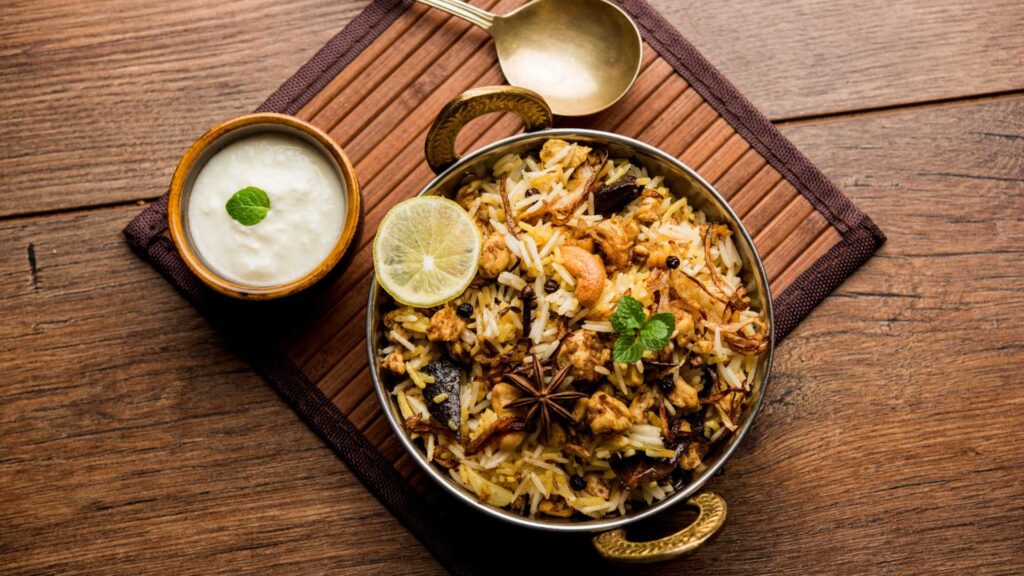
Delicious Vegetable Biryani 3 Ways (Plant-Based, Grain-Free & Oil-Free)
Ingredients
Making the Vegetable Biryani Masala
Ingredients
- 4 medium potatoes, steamed, peeled & diced
- 2 medium carrots, sliced
- 2 cups frozen green peas, thawed
- 1 small eggplant, diced
- 2 cups shiitake mushrooms, sliced
- 1 cup cauliflower, chopped (omit if using cauliflower rice)
- 2 onions, chopped
- 1 inch-knob ginger, diced
- 6 cloves, garlic, crushed
- 1 Tbsp garlic paste
- 1 Tbsp ginger paste
- 1 whole green chili, optional
- 2 Roma or plum tomatoes, diced
- 2 green chili's, slit lengthways
- ½ cup plain coconut yogurt (or Culina Coconut Yogurt)
- 1 tsp red chili powder or to taste
- 1 tsp coriander powder
- 1 tsp turmeric powder
- 1 tsp cumin powder
- 1 tsp garam masala powder
- 5 green cardamom pods
- 3 black cardamom pods
- 3 whole cloves
- 2 Indian Bay Leaves
- ½ cinnamon stick
- 1 tsp cumin seeds
- 1 star anise seed
- ½ tsp ground black pepper
- 10-12 strands of saffron
- 3 Tbsp coconut milk lite
- 2 cups vegetable broth or water (for sautéing)
- 2 cups fresh cilantro, chopped
- ½ cup fresh mint, ribboned
- ½ cup dried apricots, chopped
- ½ cup raisins
- ⅓ cup cashews, toasted
- Lemon juice drizzle, to finish
- Sea salt to taste
Instructions
Method
- Start by soaking the saffron strands in hot coconut milk for 10 - 15 minutes.
- While the saffron is soaking, toast the crushed cashews in a skillet with no oil. Stir continuously to prevent burning. Toast for about 4 - 5 minutes on medium heat. Put aside until assembly.
- If you are using caramelized onions, now is the time to make them. Or they can be made a few days ahead of time if you don’t have time to do it all on the same day. They will stay good in the fridge for up to a week.
- Then sauté the onions, garlic, ginger, bay leaf, star anise seed, and green chillis in water or vegetable broth. You really want to get the onions as brown as possible and this may mean adding 1 tbsp of vegetable broth at a time to prevent sticking. This process takes approximately 7 - 8 minutes.
- Add ginger and garlic paste, along with 2 tbsp of water or vegetable broth, and continue to cook.
- Add all the cut vegetables, 1 cup cilantro, and ¼ cup mint, and continue to sauté for another 4 - 5 minutes. Do add another 1 - 2 tbsp of water or vegetable broth to prevent sticking.
- Add the tomatoes, chili powder, coriander powder, turmeric powder, cumin powder, ground black pepper and continue to sauté until the vegetables are thoroughly cooked. Keep adding vegetable broth or water to prevent sticking.
- Add the coconut yogurt to the vegetable mixture and the garam masala, green cardamom pods, black cardamom, cloves and cinnamon stick. Cook until you can no longer see the yogurt.
- Your biryani masala is ready!
- Assemble your biryani.
Assembly
Ingredients
- Dried apricots
- Raisins
- Roasted cashews
- Fresh mint
- Fresh Cilantro
- Caramelized onions
Method
- Assembly of biryani is an art in an of itself. If you are going to put the biryani on “dhum” then I suggest layering in large pot. If you are not going to cook on ‘dhum’ then you can layer the biryani directly onto the serving platter.
- Layer the rice on the bottom of the pan. I usually do 3 - 4 layers.
- On top of the rice, I add a layer of biryani masala, caramelized onions, cashews, raisins, apricots, cilantro and mint.
- Then I add another layer of rice and continue the process until I am done with the rice and biryani masala. I always save some of the cilantro, mint and cashews for garnishing the top of the biryani.
- Pour the saffron-infused milk over the biryani. And ‘gently’ fold - not a thorough mixing by any means! This will allow the color and aroma of the biryani to be infused with saffron, which adds the final touch to the recipe.
- You follow the same assembly instructions whether you are using millet or cauliflower rice.
- Once the biryani is layered in the pot, place a kitchen towel over the biryani and place the lid tightly on top to not let any of the steam escape.
- Place this pot on a hot griddle for about 20 - 24 minutes on low heat. If you do not have a griddle, then use a pancake griddle or flat sauté pan and place the biryani pot on top of that. It allows a more even distribution of heat, without burning the food on the bottom of the pot. This is how you cook on ‘dhum’.
- Once the biryani is done cooking on dhum then transfer to a serving platter. It is an impressive-looking dish that will be the center of any celebration or special occasion.
- Garnish with extra cilantro, mint and a drizzle of lemon juice to finish!
Whenever I post our traditional Pakistani cuisine on Instagram, the recipe everyone asks me for is my Delicious Vegetable Biryani recipe! I have made this recipe in its original form for years with chicken, lamb or shrimp (before we changed our diets), which is how it’s traditionally made.
Over the years, the recipe has transformed in different ways to suit different dietary needs, and I want to share three different ways that we have made it: Vegetable Biryani with Rice, Vegetable Biryani with Millet, and Vegetable Biryani with Cauliflower Rice.
Vegetable biryani takes time to make. I suggest that you read through the recipe and familiarize yourself with the steps involved so you can make it without feeling overwhelmed.
Some of you may not have all the ingredients – especially the spices. I have tried to make this easier for everyone by including links to all the spices you need in my Amazon store.
I have outlined all the steps required to make vegetable biryani below – to give you a roadmap, the final product is made by layering the different components like the rice, saffron milk, toasted cashews, raisins, apricots, herbs, and the biryani vegetable masala. I have also indicated which steps can be done separately or ahead of time.
History of Biryani
Biryani was a dish that originated with the Persians and made its way to the Muslims of South Asia. It was cooked for the Mughal Emperors of India and is made for special occasions and celebrations like weddings and Eid – my grandmother made Biryani at least once a month, and my mom continued that tradition. The smell of Biryani is the smell of childhood happiness for me.
Typically biryani is made with rice and meat and uses ghee or clarified butter, yogurt, and milk. I have made my Vegetable Biryani version here without any dairy or meat, it and still retains all the flavors of my childhood.
What are the different steps involved in making Vegetable Biryani Three Ways?
- Choose whether you want to make the recipe with rice, millet, or cauliflower rice. (these can also be made ahead of time)
- Make sure you have all the spices.
- Make the saffron milk (can be made ahead of time, before you start the Biryani Masala)
- Caramelize onions (can be made ahead of time)
- Toast the cashew nuts (can be made ahead of time)
- Make the biryani vegetable masala.
- Assemble the biryani
- Put the biryani on ‘dhum’ which is a way of slow cooking to allow integration and blending of all the layers and ingredients. Typically this cooking method was important with meat, to infuse its flavors into the rice, but it works really really well for vegetables too.
- If you choose not to add the ‘dhum’ to the biryani, your dish can still taste incredible, but the slow cooking has a charm and flavor all its own.
Biryani is a meal that can be eaten by itself, but you can serve it with Spicy Pakistani eggplant, Raita – Spiced Coconut Yogurt, or with dahl. If you would like to stay low fat while enjoying Biryani, skip the Raita and add another side of veggies or my fat-free oil-free dahl.
Why did I create Vegetable Biryani Three Ways?
Why Rice?
Rice is the traditional way to make Biryani. Basmati rice is a staple in South Asian cuisine – Pakistan, India, Bangladesh & Sri Lanka. Of course, in some regions, the flatbread – chapati or roti is more popular, but rice is loved by most and is used in many forms, including rice flour.
While you are healing, you may be avoiding rice – in that case, please see the options below.
If, however, you are able to handle rice, I recommend purchasing an organic brand of Basmati Rice. You want to purchase rice that says “long-grain” on the packet because it will expand and lengthen as it cooks. I purchase rice about 1 – 2 times a year because rice is a treat for us! And for the purpose of making traditional Biryani, it is totally worth it! For the rice recipe linked below, make 2 – 3 cups of rice for the Vegetable Biryani Masala quantity above.
*Prepping Perfect Basmati Rice Recipe
Why Millet?
The reason that I created other options than rice is that rice is not the best grain to consume on a regular basis. Millet, for example (Bajra in Urdu or Hindi), is a much healthier grain. Millet is cooked very similarly to rice as per the instructions I share below. To match the quantity of Vegetable Biryani Masala listed in this recipe, make about 2- 3 cups of uncooked millet.
*Perfectly Fluffy Millet Recipe
Why Cauliflower Rice?
I was so excited to make a grain-free Vegetable Biryani. I struggled with grains for the longest time. It has taken me about 10 years to be able to eat grains without a severe reaction, and even then, I can only have them very occasionally.
While gluten-free grains like rice or millet do not feed chronic illnesses, some people with chronic illnesses struggle with grains. For some people with eczema, other skin conditions, asthma, chronic coughs, UTIs, yeast infections, or digestive concerns, grains can be hard to tolerate, but they are not problematic for everyone with these issues.
Another reason for avoiding grain is that it is considered a filler food. Filler foods are not harmful to us; however, they can take up space from healing foods.
This is why I created a Biryani recipe that can be enjoyed by people who do not tolerate even gluten-free grains very well. Enter, cauliflower rice.
Cauliflower can be prepped into a ‘riced’ texture by blitzing it in the food processor for a few minutes. The great thing about this is that you can purchase already riced cauliflower from your local supermarket, you can buy frozen riced cauliflower from Costco, or even this clean pantry option with no added salt or oils. Whichever version of cauliflower rice you are using, whether fresh or frozen, steam the cauliflower rice for approximately 10 minutes in a steaming basket and it is ready to fold into your Vegetable Biryani Masala.
I hope you will enjoy all these ways, depending on where you are in your healing journey!
Making the Vegetable Biryani Masala
Ingredients
- 4 medium potatoes, steamed, peeled & diced
- 2 medium carrots, sliced
- 2 cups frozen green peas, thawed
- 1 small eggplant, diced
- 2 cups shiitake mushrooms, sliced
- 1 cup cauliflower, chopped (omit if using cauliflower rice)
- 2 onions, chopped
- 1-inch knob, ginger, diced
- 6 cloves, garlic, crushed
- 1 tbsp garlic paste
- 1 tbsp ginger paste
- 1 whole green chili, optional
- 2 Roma or plum tomatoes, diced
- 2 green chillis, slit lengthways
- ½ cup plain coconut yogurt (or Culina Coconut Yogurt, omit if fat-free)
- 1 tsp red chili powder or to taste
- 1 tsp coriander powder
- 1 tsp turmeric powder
- 1 tsp cumin powder
- 1 tsp garam masala powder
- 5 green cardamom pods
- 3 black cardamom pods
- 3 whole cloves
- 2 Indian Bay Leaves
- ½ cinnamon stick
- 1 tsp cumin seeds
- 1 star anise seed
- ½ tsp ground black pepper
- 10 – 12 strands of saffron
- 3 tbsp lite coconut milk (omit if fat-free)
- 2 cups vegetable broth or water (for sautéing)
- 2 cups fresh cilantro, chopped
- ½ cup fresh mint, ribboned
- ½ cup dried apricots, chopped
- ½ cup raisins
- ⅓ cup cashews toasted
- Lemon juice drizzle, to finish
- Sea salt to taste
Method
- Start by soaking the saffron strands in hot coconut milk for 10 – 15 minutes. If you want to remain fat-free, please watch this video for how I layer in the saffron with no plant milk.
- While the saffron is soaking, toast the crushed cashews in a skillet with no oil. Stir continuously to prevent burning. Toast for about 4 – 5 minutes on medium heat. Put aside until assembly.
- If you are using caramelized onions, now is the time to make them. Or they can be made a few days ahead of time if you don’t have time to do it all on the same day. They will stay good in the fridge for up to a week.
- Then sauté the onions, garlic, ginger, bay leaf, star anise seed, and green chillis in water or vegetable broth. You really want to get the onions as brown as possible and this may mean adding 1 tbsp of vegetable broth at a time to prevent sticking. This process takes approximately 7 – 8 minutes.
- Add ginger and garlic paste, along with 2 tbsp of water or vegetable broth, and continue to cook.
- Add all the cut vegetables, 1 cup cilantro, and ¼ cup mint, and continue to sauté for another 4 – 5 minutes. Do add another 1 – 2 tbsp of water or vegetable broth to prevent sticking.
- Add the tomatoes, chili powder, coriander powder, turmeric powder, cumin powder, and ground black pepper and continue to sauté until the vegetables are thoroughly cooked. Keep adding vegetable broth or water to prevent sticking.
- Add the coconut yogurt to the vegetable biryani mixture and the garam masala, green cardamom pods, black cardamom, cloves, and cinnamon stick. Cook until you can no longer see the yogurt. If remaining fat-free you can leave the yogurt out.
- Your biryani masala is ready!
- Assemble your biryani
*watch me assemble vegetable biryani
Assembly of Vegetable Biryani
Ingredients
- Dried apricots
- Roasted cashews
- Raisins
- Fresh mint
- Fresh Cilantro
- Caramelized onions
Method
- Assembly of biryani is an art in and of itself. If you are going to put the biryani on ‘dhum’ then I suggest layering in a large pot. If you are not going to cook on ‘dhum’ then you can layer the biryani directly onto the serving platter.
- Layer the rice (or millet or riced cauliflower) on the bottom of the pan. I usually do 3 – 4 layers.
- On top of the rice, I add a layer of biryani masala, caramelized onions, cashews, raisins, apricots, cilantro, and mint.
- Then I add another layer of rice and continue the process until I am done with the rice and biryani masala. I always save some of the cilantro, mint, and cashews for garnishing the top of the biryani.
- Pour the saffron-infused milk over the biryani. And ‘gently’ fold – not a thorough mixing by any means! This will allow the color and aroma of the biryani to be infused with saffron, which adds the final touch to the recipe.
- You follow the same assembly instructions whether you are using millet or cauliflower rice.
- Once the biryani is layered in the pot, place a kitchen towel over the biryani and place the lid tightly on top to not let any of the steam escape.
- Place this pot on a hot griddle for about 20 – 24 minutes on low heat. If you do not have a griddle, then use a pancake griddle or flat sauté pan and place the biryani pot on top of that. It allows a more even heat distribution, without burning the food on the bottom of the pot. This is how you cook on ‘dhum’.
- Once the biryani is done cooking on dhum then transfer to a serving platter. It is an impressive-looking dish that will be the center of any celebration or special occasion.
- Garnish with extra cilantro, mint, and a drizzle of lemon juice to finish!
I know this is an involved recipe, but it is worth every step. Please leave me a comment below if you make this; I’d love to know how your Vegetable Biryani turns out.
To your health & happiness,
Muneeza





